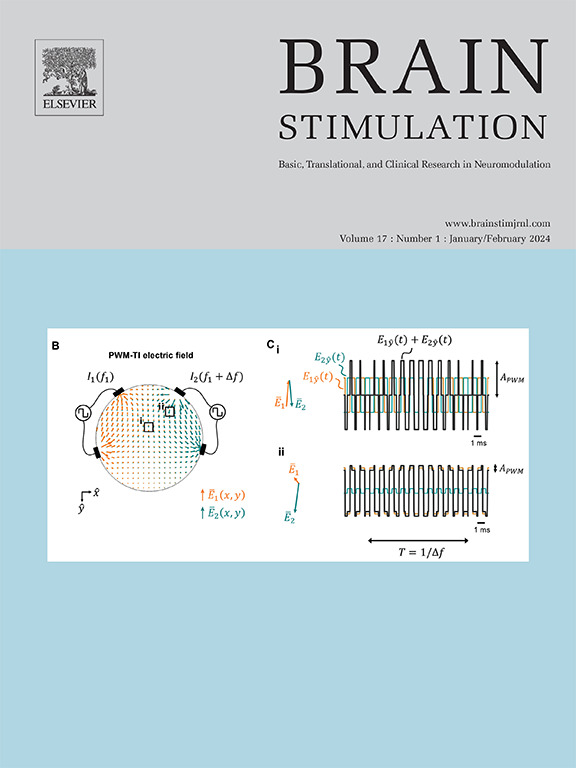Deep transcranial ultrasound stimulation using personalized acoustic metamaterials improves treatment-resistant depression in humans
IF 7.6
1区 医学
Q1 CLINICAL NEUROLOGY
引用次数: 0
Abstract
Background
Neuromodulation of deep brain regions has shown promise for treatment-resistant depression (TRD). However, it currently requires neurosurgical electrode implantation, posing significant risks and limiting widespread use while TRD affects around 100 million people worldwide. Low-intensity transcranial ultrasound stimulation (TUS) could allow precise and non-invasive deep neuromodulation, provided that the challenge of the defocusing effects of the skull is tackled.
Objective/hypothesis
Here, we present the development of a portable and neuronavigated TUS prototype based on the use of patient-specific metamaterials (metalens) that correct for skull-induced aberrations. We then present the first application of metalens-based Transcranial Ultrasound Stimulation (mTUS) in TRD. The primary objective was to assess the safety and efficacy of mTUS targeting on individual level specific white matter tracts of the subcallosal cingulate involved in TRD.
Methods
The safety and precision of this device was addressed through a series of numerical simulations and experimental measurements on ex vivo human skulls. Five participants with TRD were included in this open-label study (ClinicalTrials.gov identifier: NCT06085950) and underwent an intensive 5-day course of mTUS with a total of 25 sessions of 5 min each.
Results
No serious adverse events occurred during the study. By day 5 of treatment, depression severity was reduced by an average of 60.9 % (range: [30 %–83.9 %]), and four out of five patients qualified as responders, with two of them in remission.
Conclusions
This study provides first-in-human evidence of the potential of mTUS as a precise, safe and effective non-invasive neuromodulation technique for neuropsychiatric disorders involving deep brain regions, offering a safer and more accessible alternative to invasive approaches.
使用个性化声学超材料的深度经颅超声刺激改善人类治疗抵抗性抑郁症
脑深部区的神经调节已经显示出治疗难治性抑郁症(TRD)的希望。然而,目前需要神经外科电极植入,存在重大风险并限制了广泛使用,而TRD影响全球约1亿人。低强度经颅超声刺激(TUS)可以实现精确和非侵入性的深度神经调节,前提是解决了颅骨散焦效应的挑战。目的/假设在此,我们提出了一种便携式神经导航TUS原型的开发,该原型基于使用患者特定的超材料(超材料)来纠正颅骨诱导的畸变。然后,我们提出了基于金属的经颅超声刺激(mTUS)在TRD中的首次应用。主要目的是评估mTUS靶向与TRD有关的胼胝体扣带下个体水平特异性白质束的安全性和有效性。方法通过对离体人头骨进行一系列数值模拟和实验测量,验证该装置的安全性和精度。5名TRD患者被纳入这项开放标签研究(ClinicalTrials.gov标识符:NCT06085950),并接受了为期5天的强化mTUS课程,共25次,每次5分钟。结果研究过程中未发生严重不良事件。在治疗的第5天,抑郁症的严重程度平均降低了60.9%(范围:[30% - 83.9%]),5名患者中有4名达到应答,其中2名缓解。本研究首次在人体上证明了mTUS作为一种精确、安全、有效的非侵入性神经调节技术的潜力,为涉及深部脑区的神经精神疾病提供了一种更安全、更容易获得的替代方法。
本文章由计算机程序翻译,如有差异,请以英文原文为准。
求助全文
约1分钟内获得全文
求助全文
来源期刊

Brain Stimulation
医学-临床神经学
CiteScore
13.10
自引率
9.10%
发文量
256
审稿时长
72 days
期刊介绍:
Brain Stimulation publishes on the entire field of brain stimulation, including noninvasive and invasive techniques and technologies that alter brain function through the use of electrical, magnetic, radiowave, or focally targeted pharmacologic stimulation.
Brain Stimulation aims to be the premier journal for publication of original research in the field of neuromodulation. The journal includes: a) Original articles; b) Short Communications; c) Invited and original reviews; d) Technology and methodological perspectives (reviews of new devices, description of new methods, etc.); and e) Letters to the Editor. Special issues of the journal will be considered based on scientific merit.
 求助内容:
求助内容: 应助结果提醒方式:
应助结果提醒方式:


